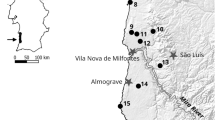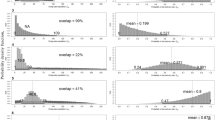Abstract
False negative detections may bias the surveys for rare species and reduce the reliability of models based on the proportion of occupied patches. We assessed the detectability of the Eurasian otter Lutra lutra through the standard survey method by analysing the detection history of 28 sampling stretches surveyed monthly between March 2001 and January 2003. Each survey negative for otter spraints was considered as a false negative if the otter had been recorded in the previous and/or following month (respectively, cFN and FN). Otter marking intensity (MI) (MI=N° of spraints per kilometre) was calculated and assumed to represent an index of its relative abundance. Spraints were found in 81.7% of all surveys. Yearly MI ranged from 1.02 to 101.4 spraints per kilometre. In 2002, mean MI was significantly lower than in the previous year, while no clear seasonal trend could be outlined. The minimum number of surveys required to establish the occurrence of the otter, as estimated by a probability model, was 2.6 and was inversely related to MI. For a sub-sample of 18 sampling stretches, the relation between the frequency of both cFN and FN and five variables of potential interest for otters was tested by means of stepwise linear multiple regressions, yielding two highly significant models, which both included only MI as the explanatory variable. The frequency of both FN and cFN was correlated to MI and the resulting equations used to assess the percentage of surveys positive for otters in both years. After the correction for non-detections, otter site occupancy did not vary between the 2 years, except for one river when applying the more conservative estimate of false negatives (cFN). Multiple visits and the assessing of MI should become standard components of otter surveys. This approach has broad applicability and may be applied to assess the large-scale distribution of other rare or elusive mammalian carnivores.




Similar content being viewed by others
References
Addicott JF, Aho JM, Antolin MF, Padilla DK, Richardson JS, Soluk DA (1987) Ecological neighborhoods: scaling environmental patterns. Oikos 49:340–346
Bailey LL, Simons TR, Pollock KH (2004) Estimating site occupancy and species detection probability parameters for terrestrial salamanders. Ecol Appl 14:692–702
Barbraud C, Nichols JD, Hines JE, Hafner H (2003) Estimating rates of extinction and colonization in colonial species and an extension to the metapopulation and community levels. Oikos 101:113–126
Bayley PB, Peterson JT (2001) An approach to estimate probability of presence and richness of fish species. Trans Am Fish Soc 130:620–633
Cassola F (1986) The otter in Italy. Status, distribution and conservation of an endangered species. Serie Atti e Studi 5. WWF Italia, Roma
Chanin P (2003) Monitoring the otter Lutra lutra. Conserving Natura 2000 Rivers Monitoring Series No. 10. English Nature, Peterborough
Clavero M, Prenda J, Delibes M (2006) Seasonal use of coastal resources by otters: comparing sandy and rocky stretches. Estuar Coast Shelf Sci 66:387–394
Cortés Y, Fernández-Salvador R, García FJ, Virgós E, Llorente M (1998) Changes in otter Lutra lutra distribution in Central Spain in the 1964–1995 period. Biol Conserv 86:179–183
De Solla SR, Shirose LJ, Fernie KJ, Barrett GC, Brousseau CS, Bishop CA (2005) Effect of sampling effort and species detectability on volunteer based anuran monitoring programs. Biol Conserv 121:585–594
Gallant D, Vasseur L, Berube CH (2008) Evaluating bridge survey ability to detect river otter Lontra canadensis presence: a comparative study. Wildlife Biol 14:61–69
Gasith A, Resh VH (1999) Streams in Mediterranean climate regions—abiotic influences and biotic responses to predictable seasonal events. Ann Rev Ecolog Syst 30:51–81
Gese EM (2001) Monitoring of terrestrial carnivore populations. In: Gittleman JL, Funk SM, Macdonald D, Wayne RK (eds) Carnivore conservation. Cambridge University Press, London, pp 372–396
Gosling LM, McKay HV (1990) Competitor assessment by scent marking: an experimental test. Behav Ecol Sociobiol 26:415–420
Gu W, Swihart RK (2004) Absent or undetected? Effects of non-detection of species occurrence on wildlife–habitat models. Biol Conserv 116:195–203
Hongve D (1987) A revised procedure for discharge measurement by means of the salt dilution method. Hydrol Process 1:267–270
Jackson JT, Weckerly FW, Swannack TM, Forstner MRJ (2006) Inferring absence of Houston toads given imperfect detection probabilities. J Wildl Manage 70(5):1461–1463
Janssens X, Defourny P, De Kermabon J, Baret PV (2006) The recovery of the otter in the Cevennes (France): a GIS-based model. Hystrix It J Mamm (NS) 17(1):5–14
Jedrzejewska B, Sidorovich VE, Pikulik MM, Jedrzejewski W (2001) Feeding habits of the otter and the American mink in Bialowieza Primeval Forest (Poland) compared to other Eurasian populations. Ecography 24:165–180
Jefferies DJ (1986) The value of otter Lutra lutra surveying using spraints: an analysis of its success and problems in Britain. Otters 1(9):25–32
Kéry M (2002) Inferring the absence of a species—a case study of snakes. J Wildl Manage 66:330–338
Kruuk H (1995) Scent marking by otters (Lutra lutra): signaling the use of resources. Behav Ecol 3:133–140
Kruuk H, Conroy JWH (1987) Surveying otter Lutra lutra populations: a discussion of problems with spraints. Biol Conserv 41:179–183
Kruuk H, Conroy WH, Glimmerveen U, Ouwerkerk EJ (1986) The use of spraints to survey populations of otters Lutra lutra. Biol Conserv 35:187–194
Lanszki J, Hidas A, Szentes K, Révay T, Lehoczky I, Weiss S (2008) Relative spraint density and genetic structure of otter (Lutra lutra) along the Drava River in Hungary. Mamm Biol 73:40–47
Lenton EJ, Chanin PRF, Jefferies DJ (1980) Otter survey of England 1977–79. Nature Conservancy Council, London
Lopez JE, Pfister CA (2001) Local population dynamics in metapopulation models: implications for conservation. Cons Biol 15:1700–1709
Mackenzie DI, Nichols JD (2004) Occupancy as a surrogate for abundance estimation. Anim Biodivers Conserv 27:461–467
MacKenzie DI, Royle JA (2005) Designing efficient occupancy studies: general advice and tips on allocation of survey effort. J Appl Ecol 42:1105–1114
MacKenzie DI, Nichols JD, Lachman GB, Droege S, Royle JA, Langtimm CA (2002) Estimating site occupancy rates when detection probabilities are less than one. Ecology 83:2248–2255
MacKenzie DI, Nichols JD, Hines JE, Knutson MG, Franklin AD (2003) Estimating site occupancy, colonization and local extinction probabilities when a species is not detected with certainty. Ecology 84:2200–2207
Mackenzie DI, Nichols JD, Sutton N, Kawanishi K, Bailey L (2005) Improving inferences in population studies of rare species that are detected imperfectly. Ecology 86(5):1101–1113
Magalhães MF, Batalha DC, Collares-Pereira MJ (2002) Gradients in stream fish assemblages across a Mediterranean landscape: contributions on environmental factors and spatial structure. Freshw Biol 47:1015–1031
Manly BF (1997) Randomization, bootstrap, and Monte Carlo methods in biology, 2nd edn. Chapman and Hall, London
Mason CF, Macdonald SM (1987) The use of spraints for surveying otter (Lutra lutra) populations: an evaluation. Biol Conserv 41:167–177
Mason CF, Macdonald SM (1993) Impact of organochlorine pesticide residues and PCBs on otters (Lutra lutra): a study from western Britain. Sci Total Environ 138:127–145
Mason CF, Macdonald SM (2004) Growth in otter (Lutra lutra) populations in the UK as shown by long-term monitoring. Ambio 33:148–152
McArdle BH (1990) When are rare species not there? Oikos 57:276–277
Nupp TE, Swihart RK (1996) Effect of forest patch area on population attributes of white-footed mice (Peromyscus leucopus) in fragmented landscapes. Can J Zool 74:467–472
Prigioni C (1997) La lontra. Una vita silenziosa negli ambienti acquatici. Edagricole, Bologna
Prigioni C, Remonti L, Balestrieri A, Sgrosso S, Priore G, Misin CE, Viapiana M, Spada S, Anania R (2005) Distribution and sprainting activity of the otter (Lutra lutra) in the Pollino National Park (Southern Italy). Ethol Ecol Evol 17(2):171–180
Prigioni C, Remonti L, Balestrieri A, Sgrosso S, Priore G, Mucci N, Randi E (2006a) Estimation of European otter (Lutra lutra) population size by fecal DNA typing in southern Italy. J Mamm 87:855–858
Prigioni C, Remonti L, Balestrieri A (2006b) Otter Lutra lutra movements assessed by genotyped spraints in Southern Italy. Hystrix It J Mamm 17:91–96
Prigioni C, Balestrieri A, Remonti L (2007) Decline and recovery in otter Lutra lutra populations in Italy. Mamm Rev 37(1):71–79
Pulliam HR (1988) Sources, sinks, and population regulation. Am Nat 132:652–661
Reed JM (1996) Using statistical probability to increase confidence of inferring species extinction. Conserv Biol 10:1283–1285
Remonti L, Prigioni C, Balestrieri A, Sgrosso S, Priore G (2008) Distribution of a recolonising species may not reflect habitat suitability alone: the case of the Eurasian otter (Lutra lutra) in southern Italy. Wildlife Res 35:798–805
Reuther C, Dolch D, Green R, Jahrl J, Jefferies D, Krekemeyer A, Kucerova M, Madsen AB, Romanowski J, Roche K, Ruiz-Olmo J, Teubner J, Trinidade A (2000) Surveying and monitoring distribution and population trends of the Eurasian Otter (Lutra lutra)—guidelines and evaluation of the standard method for surveys as recommended by the European Section of the IUCN/SSC Otter Specialist Group. Habitat No. 12, Hankensbüttel
Roos A, Greyerz E, Olsson M, Sandegren F (2001) The otter Lutra lutra in Sweden—population trends in relation to total DDT and total PCB concentrations during 1968–99. Environ Pollut 111:457–469
Royle JA, Nichols JD (2003) Estimating abundance from repeated presence–absence data or point counts. Ecology 84:777–790
Ruiz-Olmo J (1998) Influence of altitude on the distribution, abundance and ecology of the otter (Lutra lutra). In: Dunstone N, Gorman ML (eds) Behaviour and ecology of riparian mammals. Symposia of the Zoological Society of London. Cambridge University Press, Cambridge, pp 159–176
Ruiz-Olmo J, Gosálbez J (1997) Observations on the sprainting behaviour of the otter Lutra lutra in the NE Spain. Acta Theriol 42(3):259–270
Ruiz-Olmo J, Saavedra D, Jimenéz J (2001) Testing the surveys and visual and track censuses of Eurasian otters (Lutra lutra). J Zool Lond 253:359–369
Sadlier LMJ, Webbon CC, Baker PJ, Harris S (2004) Methods of monitoring red foxes Vulpes vulpes and badgers Meles meles: are field signs the answer? Mamm Rev 34(1):75–98
Schmidt BR (2005) Monitoring the distribution of pond-breeding amphibians when species are detected imperfectly. Aquat Conserv Mar Freshw Environ 15:681–692
Smiroldo G, Balestrieri A, Remonti L, Prigioni C (2009) Seasonal and habitat-related variation of otter Lutra lutra diet in a Mediterranean river catchment (Italy). Folia Zool 58(1):87–97
Strachan R, Jefferies DJ (1996) The otter survey of England 1991–1994. Vincent Wildlife Trust, London
Tyre AJ, Tenhumberg B, Field SA, Niejalke D, Parris K, Possingham HP (2003) Improving precision and reducing bias in biological surveys: estimating false-negative error rates. Ecol Appl 13(6):1790–1801
Wood M (2005) Bootstrapped confidence intervals as an approach to statistical inference. Organ Res Meth 8:454–470
Acknowledgements
This study was promoted and financially supported by the Pollino National Park. We wish to thank Silvia Sgrosso, Giuseppe Priore, Chiara Misin, Monica Viapiana, Sabina Spada and Roberta Anania for their help in field research. We are grateful to C. F. Mason and three anonymous referees for their comments and suggestions.
Author information
Authors and Affiliations
Corresponding author
Electronic supplementary material
Below is the link to the electronic supplementary material.
ESM 1
(DOC 98 kb)
Rights and permissions
About this article
Cite this article
Balestrieri, A., Remonti, L. & Prigioni, C. Detectability of the Eurasian otter by standard surveys: an approach using marking intensity to estimate false negative rates. Naturwissenschaften 98, 23–31 (2011). https://doi.org/10.1007/s00114-010-0737-0
Received:
Revised:
Accepted:
Published:
Issue Date:
DOI: https://doi.org/10.1007/s00114-010-0737-0




